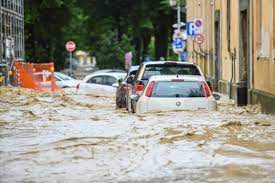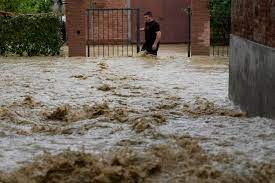Italy: ‘Once in a century’ deadly floods are linked to climate crisis, researchers say

Rome: Deadly floods that have engulfed the northern Italian region of Emilia Romagna, killing at least 14 people, are another sign of the accelerating climate crisis, according to researchers.
The floods come after years of severe drought in the region, which has compacted the soil, reducing its ability to abemsorb rainfall.
“Rising temperatures intensify drought episodes, drying up the soil and changing its permeability in different ways,” Mauro Rossi, a researcher at the Research Institute for Geo-Hydrological Protection, part of the Italian National Research Council, said on Wednesday n a press release.

A man wades through floodwaters in the town of Lugo on Friday. Researchers say the devastation is linked to the climate crisis.
Extreme amounts of water falling over a short period of time exacerbate runoff, Rossi said, causing excess water to drain toward the rivers, which respond by “overflowing, burrowing and changing their riverbeds.”
More than 20 rivers in the region have burst their banks, prompting a wave of 280 landslides, the Civil Protection department said Thursday.
Among those killed was an 84-year-old man, whose body was found in the mud in the courtyard of his house in the town of Faenza. Further east, in the village of Ronta di Cesena, a married couple also died.

Up to 20,000 people have been forced to leave their homes and as many as 27,000 have been left without power, according to Enel, the Italian multinational manufacturer and distributor of electricity and gas.
According to Coldiretti, a farmers association, more than 5,000 farms were under water in Emilia Romagna, which includes an area known as “Fruit Valley,” as well as corn and grain fields.
Greenhouses and stables have also been flooded, with reports of drowned animals, Coldiretti said Thursday in a press release.





